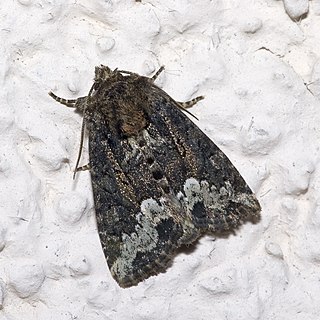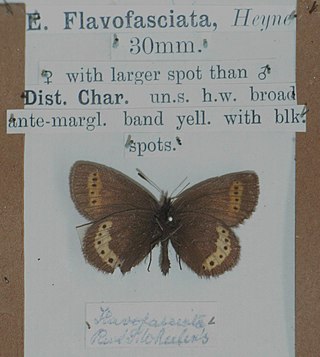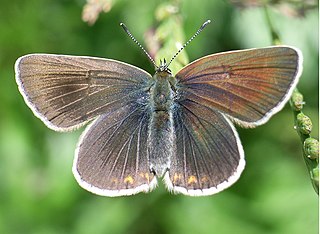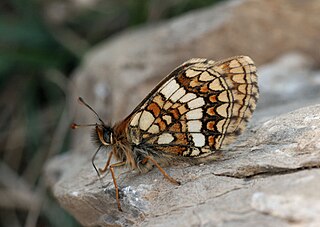
The marbled minor is a moth of the family Noctuidae. The species was first described by Carl Linnaeus in his 1758 10th edition of Systema Naturae. It is distributed throughout Europe, east through the Palearctic to central Asia and the Altai Mountains. It rises to heights of over 1500 meters in the Alps.

The carline skipper is a butterfly and a species of the skipper. It is a montane butterfly only found in southwestern areas of the Alps. It can be an abundant species within this restricted range.

The purple-shot copper is a butterfly in the family of the Lycaenidae or copper butterflies and in the genus of the Lycaena.

Melitaea diamina, the false heath fritillary, is a butterfly of the family Nymphalidae.

The scarce copper is a butterfly of the family Lycaenidae.

The yellow-banded ringlet is a member of the subfamily Satyrinae of the family Nymphalidae. It is a high mountain butterfly found in a small area of the Alps in Switzerland and Italy.

The marbled ringlet is a member of the subfamily Satyrinae of the family Nymphalidae.

Orthosia incerta, the clouded drab, is a species of moth of the family Noctuidae, found in Europe and Asia. The occurrence of the species extends through all European countries through the Palearctic to the Russian Far East and Japan. It is absent from northern Fennoscandia and in the Alps it occurs up to 2000 m above sea level.

Coenonympha hero, the scarce heath, is a butterfly species belonging to the family Nymphalidae.

Lasiommata petropolitana, the northern wall brown, is a butterfly species belonging to the family Nymphalidae. It can be found in large parts of Europe, from the Pyrenees and Alps up to Scandinavia and Finland, east to Russia and Siberia.

Boloria dia, the Weaver's fritillary or violet fritillary, is a butterfly in the family Nymphalidae. The name Weaver's fritillary is in honor of Richard Weaver, an English insect collector who claimed to have obtained the specimen within ten miles of Birmingham around 1820. However, B. dia is very rare in England and the few specimens known from there are thought to be from possibly accidental introductions.

Melitaea phoebe, also known as the Knapweed fritillary, is a butterfly of the family Nymphalidae. It is found in the Palearctic realm, except the northernmost locations. Previously it also included Melitaea telona which was recently revalidated as a distinct cryptic species.

Glaucopsyche alexis, the green-underside blue, is a butterfly of the family Lycaenidae. It is found in the Palearctic.

Eumedonia eumedon, the geranium argus, is a butterfly of the family Lycaenidae. It is found in the Palearctic realm. This butterfly has been included in the genera Plebejus, Plebeius, Polyommatus and Aricia, but recent molecular studies have demonstrated that Eumedonia is a valid genus, different from the previous genera mentioned.

Aricia nicias, the silvery argus, is a butterfly of the family Lycaenidae. It is found in the Alps, Pyrenees and from Scandinavia ranging to Siberia and the north of Mongolia.

Agriades optilete, the cranberry blue, is a butterfly of the family Lycaenidae. It is found in north eastern Europe, the Alps, North Asia, Japan, Korea and north western North America.

Polyommatus escheri, Escher's blue, is a butterfly of the family Lycaenidae. It is found in Southern Europe and Morocco.

Melitaea varia, the Grisons fritillary, is a butterfly of the family Nymphalidae. It is found in the Alps at heights of 1,500–2,600 m (4,900–8,500 ft), especially in the Swiss cantons Valais, Engadin and Graubünden. It is also found in the Ortler region in South Tyrol, Alpes-Maritimes and Drôme in France, high areas of Tirol in Austria and high areas in the Apennine Mountains such as Abruzzo.

Erebia melampus, the lesser mountain ringlet, is a member of the subfamily Satyrinae of the family Nymphalidae.

The twin-spot fritillary is a butterfly in the family Nymphalidae.





















